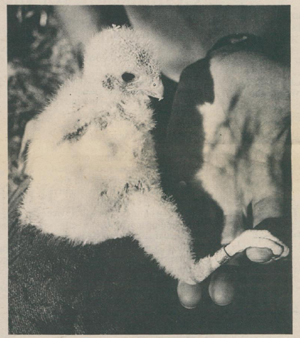
From the ITD Vault: 30 years ago
Freeway Fledglings
Pictures and story from Pete Zimowsky:
Several birds have found free housing along Idaho's freeways. Thanks to a joint project by three government organizations, nesting boxes were mounted on the backs of highway signs for the kestrel, North America's smallest falcon. Kestrels dine on grasshoppers, dragonflies, lizards and mice, which abound on the median strips of southwestern Idaho's highways.
![]() But the kestrel, a cavity nester, prefers to nest in tree holes and cliff crevices, which are scarce along the interstate.
But the kestrel, a cavity nester, prefers to nest in tree holes and cliff crevices, which are scarce along the interstate.
However, they also nest in boxes designed especially for them, which are not so scarce anymore. The Department, the Nongame Program of the Idaho Department of Fish and Game and the U.S. Bureau of Land Management put up 18 nesting boxes on signs along Interstate 84 between Simco road and Caldwell in later March. Although one box was blown down by wind, the kestrels weren't discouraged.
"A total of 56 nesting boxes were placed in southwestern Idaho," B.L.M. Wildlife Research Biologist Karen Steenhoff said. "The 17 existing nesting boxes along I-84 have had the highest occupancy rate and the highest success rate of all of them."
According to Karen, four boxes out of the 17 are inhabited. And from those four nests, 17 young were fledged.
"We'll probably have even better success next year," Rob Tiedemann, Principal Environmental Planner for the Department, said. "The boxes will be there during pre-breeding season. We put them up a little late, so we might have missed some that
bred earlier in the season." And Karen said kestrels often return to the areas where they were hatched.
As a result, motorists may see more of the kestrel. Kestrels, also known as sparrow hawks, weigh about 1/4 to 3/4 pounds and have a 21-24 inch wing span. They are often seen at roadsides, perched atop telephone poles, fence posts and trees in search of food. They often hover in the air before pouncing on their prey.
Like the kestrel, Fish and Game Biologist Craig Groves pounced upon the chance to put up nesting boxes when he read about a similar project in Iowa. According to Rob, Iowa's nesting box project was jointly sponsored between the state's Fish and Game and Transportation Departments.
"After Craig had read about it, he called me on the phone and suggested that the Idaho Fish and Game Department and our Department should get together and do the same thing," he said.
The rest is history.
But as for the future of the nesting box project, Rob did not know what to expect.
"We'll need to contact our folks to see if there were any problems," he said. "We're looking at the project as an experiment. We don't want to make it too big before we find out if it works for us or not."
However, Rob did say there are plans to put up more nesting boxes, "but Craig just wants to see how successful the program is before we do anything more."
Nevertheless, the project has already proven its success – several young kestrels have fledged, and Rob said the nesting box project cost the Department next to nothing.
"The nesting box project cost the Department virtually nothing," Rob said. "All we provided was permission to hang the boxes, as well as some of my time. And the Boy Scouts volunteered to build them."
And in spite of low costs, Rob said the Department's payoffs were great.
"The nesting boxes breed good service between us and the resource agencies," he said, "and it provides us with some real positive publicity. It shows people the Department's interested in environmental concerns. "
And to Rob, the kestrel nesting box project has an additional benefit.
"Kestrels are not endangered or threatened, but they are a species of concern." he said, primarily because there's less and less of their natural habitats available for them. A lot of people are finding that it's nice to build homes and industrial parks where those areas are."
A spring kestrel fledgling, raised in a nesting box along Interstate 84, is shown left. Above and right, Craig Groves, a biologist working with Idaho Fish & Game's Nongame Program, checks a nesting box on the freeway near Nampa.
Published 04-29-16